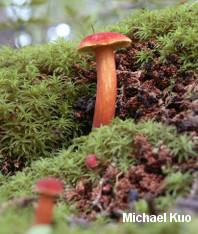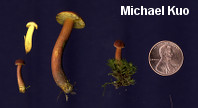| Major Groups > Boletes > Red-Capped, Blue Staining > Boletus cokeri |

|
Boletus cokeri [ Basidiomycota > Boletales > Boletaceae > Boletus . . . ] by Michael Kuo Maybe this species is a silly idea. Described from North Carolina in 1943 by Coker and Beers (as "Boletus parvulus"; see note below), its major distinguishing feature is its tiny size; Coker and Beers called it "the smallest Boletus we know." The largest caps of Boletus cokeri are about 2 cm across; other red-capped, blue-staining boletes are either a step or two larger (Boletus harrisonii and ilk, with caps 2-6 cm across) or much larger (Boletus bicolor, for example, with caps up to 15 cm or more across). Boletus cokeri features a stem that is red nearly to the apex, which also helps to separate it, along with flesh that stains blue, then reddish--and a cap surface that turns fleetingly dark gray to black when a drop of KOH is applied. So I'm going there, at least tentatively . . . but if you don't want to come along, I will understand. My sole collection was made in a hardwood forest in Illinois, in moss, and if it weren't for the red stem I would likely have assigned it to Boletus harrisonii, as a miniature version, since microscopic features match that species well. Using the generic concepts of Šutara (2008), Boletus cokeri should probably be placed in Xerocomellus. "Boletus parvulus" was the name this species was originally given by Coker and Beers (1943). However, since the authors did not realize that Boletus parvulus was already a species (named by Massee in 1909) the mushroom was given the new name of Boletus cokeri later in the same year (House, 1943). Description: Ecology: Mycorrhizal with hardwoods; growing gregariously in woods; summer; distribution uncertain. The illustrated and described collection is from Illinois. Cap: Minute to 2 cm across; convex, becoming broadly convex; dry; finely velvety; deep red; the margin yellowish when young. Pore Surface: Bright yellow at first, becoming dull olive yellow; bruising blue and then, over time, orangish to brown; with 2-3 angular pores per mm; tubes 1-2 mm deep. Stem: 2-4 cm long; up to 0.5 cm thick; more or less equal; bald; yellow at the apex; colored like the cap overall, but slightly paler; not reticulate; basal mycelium yellow. Flesh: Yellow; staining faintly greenish blue when sliced, then slowly pinkish red. Odor and Taste: Not distinctive. Chemical Reactions: Ammonia negative on cap surface; negative on flesh. KOH fleetingly dark gray to black on cap surface; rusty orange on flesh. Iron salts negative on cap surface; gray on flesh. Spore Print: Not documented. Microscopic Features: Spores 10-12 x 4-5 µ; subfusiform; smooth; yellow in KOH. Pileipellis a collapsing trichoderm of elements 5-7.5 µ wide; terminal cells often inflated and/or cystidioid; yellow in KOH. REFERENCES: (Coker & Beers, 1943) House, 1943. (Both, 1993.) Herb. Kuo 06150301. This site contains no information about the edibility or toxicity of mushrooms. |
© MushroomExpert.Com |
|
Cite this page as: Kuo, M. (2014, December). Boletus cokeri. Retrieved from the MushroomExpert.Com Web site: http://www.mushroomexpert.com/boletus_cokeri.html |

